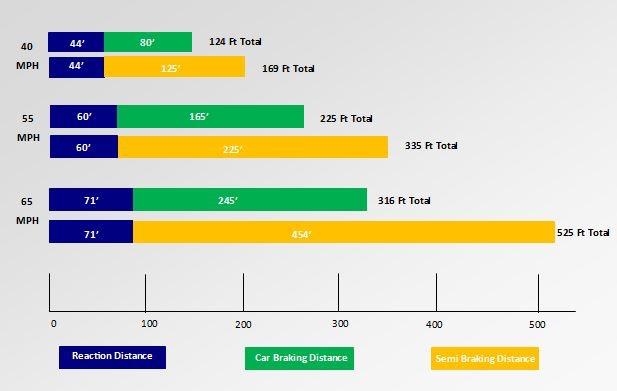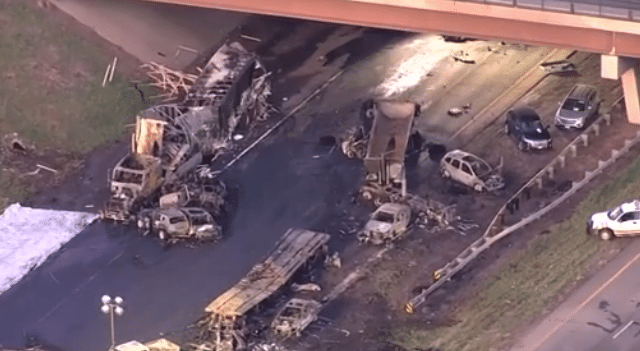 We see semi-trucks quite often, especially on Colorado highways and interstates. Such vehicles are an important part of our economy, transporting millions of products every day. There is no question that we need to share the road with these vehicles, but large tractor-trucks are troubling when it comes to wrecks.
We see semi-trucks quite often, especially on Colorado highways and interstates. Such vehicles are an important part of our economy, transporting millions of products every day. There is no question that we need to share the road with these vehicles, but large tractor-trucks are troubling when it comes to wrecks.
Given the size and weight of semi-trucks, their ability to stop is a lot slower than the sedan or SUV you may be driving. Recently, a semi-truck rear-ended a vehicle on I-70, seriously injuring the two kids in the back seat. The exact cause of why the semi-truck plowed into the other car is still being investigated, but it’s a reminder of how much worse accidents are when vehicles of this size are involved. According to the Federal Motor Carrier Safety Administration, from a 2006 study, 23 percent of truck crashes involved the truck rear ending another car. This was the most common type of wreck involving tractor-trailers.
A Semi-Truck’s Stopping Distance
The total stopping distance is the distance your vehicle travels from the time you press the brake until the vehicle stops. Think of this in a situation where you have to immediately stop because there is some kind of hazard in the road. The total stopping distance is made up of three parts:
- Perception Distance: This is the distance a vehicle travels from the time a driver sees a hazard until the brain recognizes it.
- Reaction Time: The time it takes for a driver to execute a decision once a hazard is recognized. The distance your vehicle travels while you react is called a reaction distance.
- Braking Distance: The distance a vehicle travels from the time a driver begins pressing on the brake pedal until the vehicle comes to a complete stop.
For the case of trucks, there is an additional factor of the brake lag distance in the stopping distance. Brake lag is the time it takes for a brake signal to travel to all the wheels of a tractor-trailer (it’s about ¾ of a second). So, the brake lag distance is the distance the truck travels in that time before the brakes are engaged.
The faster a semi is traveling, the longer it is going to take for it to stop. Here are some distances it would take to stop at varying speeds compared to a car:

How to Avoid Large Truck Crashes
Trucks made up 4.3% of all highway vehicles in 2009, and the number has surely grown since then. While that may seem like a small number, semi-truck crashes account for a much larger percentage of fatal traffic wrecks. Unfortunately, these wrecks are not always preventable, no matter how safely drivers of the cars around the semis are being. But there are things to consider while we’re on the road with semis that could help prevent some crashes.
Safety Tips for Cars
- BE AWARE – The best way to prevent any kind of accident it to be aware of what is going on around you. This is even more crucial when dealing with large vehicles like semi-trucks. A semi can weigh up to 80,000 pounds. In comparison, the average car weighs around 5,000 pounds. Given the weight, speed, and other factors that contribute to a semi-truck’s ability to stop or swerve, it is important that we as drivers take into consideration the physics here so that we don’t contribute to a wreck.
- DON’T TAILGATE – Due to a semi-truck’s size and shape, the driver has limited sight-line and larger blind spots than we do in our automobiles. Remember, if you are unable to see the semi’s cab mirrors when traveling behind it, then you should assume the truck driver cannot see you. Put enough distance between you and the semi-truck so that the driver can see you and so that you have enough time to stop suddenly and safely when needed.
- PASS SAFELY- You should never cut-off another driver, but especially a semi-truck. Remember, as mentioned above the vehicle has a longer time period before its brakes go into effect, the brake lag. Those crucial half seconds are not something you want to risk when trying to pass a large truck. Maintain a safe distance when passing, which is helpful to both you and the truck.
- REPORT UNSAFE DRIVING – Truck drivers are professionals who should have gone through training before getting behind the wheel. However, not all truck drivers follow the rules of the road. If you see a semi-truck driver who is driving aggressively, erratically, poorly, or unsafely in any way please report the driver right away. You can contact the State Highway Patrol or other local law enforcement. You could also contact the company that owns the truck to inform them. Often trucks have a sign that says “How is My Driving?” with a number to call.
Safety Tips for Truckers
- KNOW THE DANGERS – Operating a semi-truck can be a difficult feat, which is why there is special training involved. The weight of 80,000 pounds is extreme. So, it is important for a truck driver to understand the dangers of behind the wheel of a semi. Please be aware of the common factors associated with tractor-trailer crashes, so that you can work to prevent these incidents. The top 10 factors associated with large truck crashes according to the Federal Motor Carrier Safety Administration are:
- Brake problems
- Traffic flow interruption (congestion, previous crash)
- Prescription drug use
- Traveling too fast for road conditions
- Unfamiliarity with roadway
- Roadway issues
- Required to stop before crash (traffic control device, crosswalk)
- Over-the-counter drug use
- Inadequate surveillance
- SAFETY FIRST – We all should put safety first when on the road, including truck drivers. So, remember every time you get behind the wheel to make a conscious decision to put safety first.
- DON’T DRIVE WHEN TIRED – Driver fatigue is one of the top reasons that wrecks involving large trucks occurs. According to the National Highway Traffic Safety Administration and past studies, fatigue is a contributing factor in at least 30 to 40 percent of crashes. Sleep deprivation greatly affects a driver’s ability to safely operate a vehicle and decreases the driver’s reaction time and attention. Many truck drivers have long-distance, overnight routes, so it is important to be aware of any drowsiness you have in order to prevent crashes.
For everyone, please be aware of other vehicles and considerate of other drivers on the road.
If you enjoyed this blog, you may also be interested in these:


